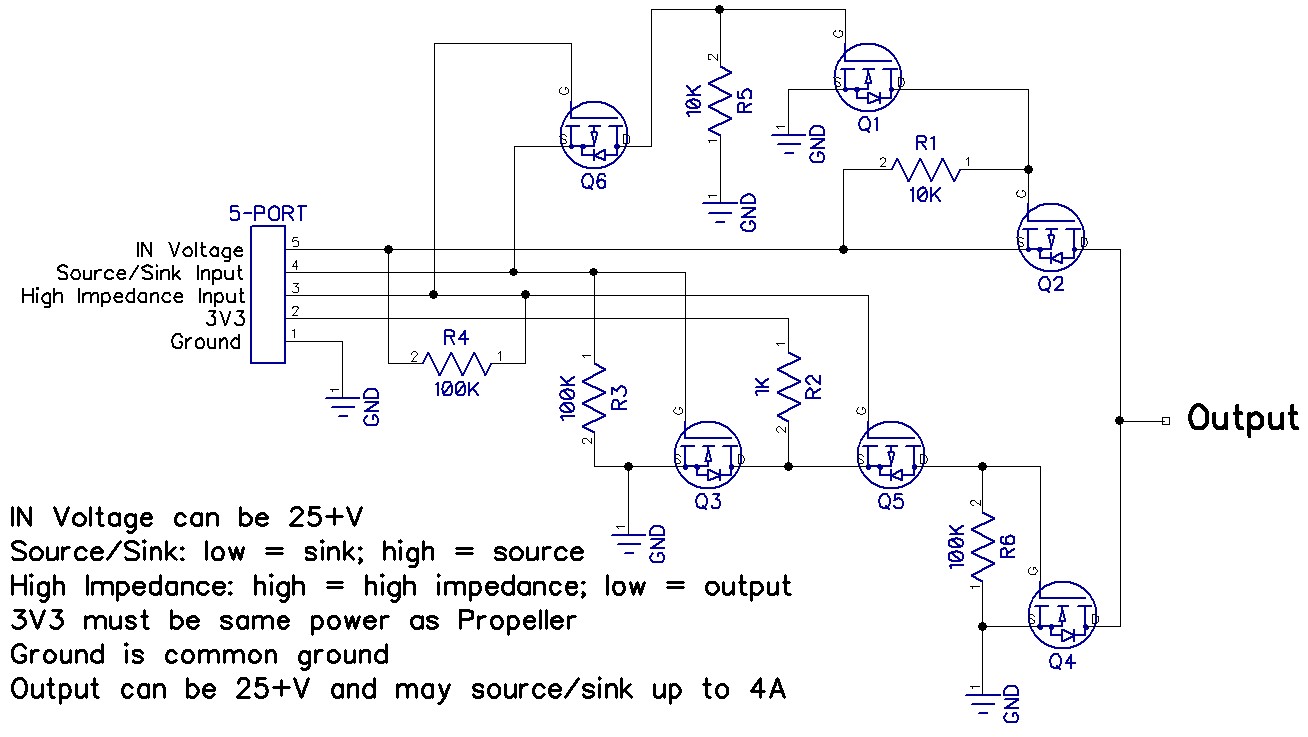Source/Sink High volts and amps with Propeller challenge
I was thinking over the weekend about trying to source and sink at least 25V and 4A using the propeller. Attached is the schematic I came up with. I am sure the people here can come up with something better. My design uses six transistors and six resistors. I am hoping to design something with common-type components, at the transistor level. Maybe someone can come up with similar functionality with less components. There is a decent possibility I messed up in my wiring too, it is untested.
There are two inputs; the first input enables and disables the second which sets sourcing or sinking. Most of the limitations of the circuit to source and sink come from the right-most N-channel and P-channel transistors. The other transistors could be cheap, low-amp MOSFETS. I found some MOSFETS in SOIC packages that could be used for the two power MOSFETs to hit 40-50V and do 10 or more amps.
The problem may be in the way I am driving the gates of the power transistors.
For the P-channel MOSFET: most MOSFETs can't handle the same voltage swing on their gates as their source-drain voltage (I am just pulling the gate to ground when it is activated, which could exceed that limit if IN Voltage is too high).
For the N-channel MOSFET: the gate would only be given about 3.27V (with 3.3V supply) when active, which may not be enough to fully open a lot of the high-amp transistors I was looking at; even the ones with fairly low thresholds on the gate work much better with higher voltages.
But possibly both are solved just by finding different transistors.
Another couple notes: the resistors could probably be reduced to help increase the maximum frequency of the circuit. I would also love to get R2 to pull to the IN Voltage rather than 3.3V because it would increase the voltage on the Q4 gate, but then there would always be negative voltage on the Q5 (P-channel) gate if the source/sink input were left low (or floating because of the R3 pull-down). Thus power would always be flowing even if the high impedance was enabled.
Any ideas on how to make this better or more succinct would be great. This will be my little challenge for the forum.
▔▔▔▔▔▔▔▔▔▔▔▔▔▔▔▔▔▔▔▔▔▔▔▔
April, 2008: when I discovered the answers to all my micro-computational-botherations!
Some of my objects:
MCP3X0X ADC Driver - Programmable Schmitt inputs, frequency reading, and more!
Simple Propeller-based Database - Making life easier and more readable for all your EEPROM storage needs.
String Manipulation Library - Don't allow strings to be the bane of the Propeller, bend them to your will!
Fast Inter-Propeller Comm - Fast communication between two propellers (1.37MB/s @100MHz)!
There are two inputs; the first input enables and disables the second which sets sourcing or sinking. Most of the limitations of the circuit to source and sink come from the right-most N-channel and P-channel transistors. The other transistors could be cheap, low-amp MOSFETS. I found some MOSFETS in SOIC packages that could be used for the two power MOSFETs to hit 40-50V and do 10 or more amps.
The problem may be in the way I am driving the gates of the power transistors.
For the P-channel MOSFET: most MOSFETs can't handle the same voltage swing on their gates as their source-drain voltage (I am just pulling the gate to ground when it is activated, which could exceed that limit if IN Voltage is too high).
For the N-channel MOSFET: the gate would only be given about 3.27V (with 3.3V supply) when active, which may not be enough to fully open a lot of the high-amp transistors I was looking at; even the ones with fairly low thresholds on the gate work much better with higher voltages.
But possibly both are solved just by finding different transistors.
Another couple notes: the resistors could probably be reduced to help increase the maximum frequency of the circuit. I would also love to get R2 to pull to the IN Voltage rather than 3.3V because it would increase the voltage on the Q4 gate, but then there would always be negative voltage on the Q5 (P-channel) gate if the source/sink input were left low (or floating because of the R3 pull-down). Thus power would always be flowing even if the high impedance was enabled.
Any ideas on how to make this better or more succinct would be great. This will be my little challenge for the forum.
▔▔▔▔▔▔▔▔▔▔▔▔▔▔▔▔▔▔▔▔▔▔▔▔
April, 2008: when I discovered the answers to all my micro-computational-botherations!
Some of my objects:
MCP3X0X ADC Driver - Programmable Schmitt inputs, frequency reading, and more!
Simple Propeller-based Database - Making life easier and more readable for all your EEPROM storage needs.
String Manipulation Library - Don't allow strings to be the bane of the Propeller, bend them to your will!
Fast Inter-Propeller Comm - Fast communication between two propellers (1.37MB/s @100MHz)!



Comments
Peter Jakacki has posted a version that I really like here ... docs.google.com/View?docID=0AVS8dcreQOsuZGRncThrNGJfMWQ3ajRkMmZo&revision=_latest
For 3.3V operation I would suggest changing the 10K resistor(R6) in his schematic to 4.7K instead.
▔▔▔▔▔▔▔▔▔▔▔▔▔▔▔▔▔▔▔▔▔▔▔▔
Beau Schwabe
IC Layout Engineer
Parallax, Inc.
▔▔▔▔▔▔▔▔▔▔▔▔▔▔▔▔▔▔▔▔▔▔▔▔
Leon Heller
Amateur radio callsign: G1HSM
▔▔▔▔▔▔▔▔▔▔▔▔▔▔▔▔▔▔▔▔▔▔▔▔
April, 2008: when I discovered the answers to all my micro-computational-botherations!
Some of my objects:
MCP3X0X ADC Driver - Programmable Schmitt inputs, frequency reading, and more!
Simple Propeller-based Database - Making life easier and more readable for all your EEPROM storage needs.
String Manipulation Library - Don't allow strings to be the bane of the Propeller, bend them to your will!
Fast Inter-Propeller Comm - Fast communication between two propellers (1.37MB/s @100MHz)!